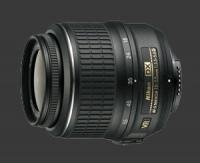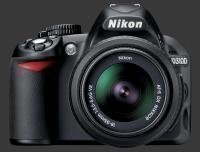Nikon D3100 Review
Nikon D3100 Performance - How well does it take pictures?
Ultimately, it is image quality that makes a camera worth buying. For an SLR, image quality greatly depends on the lens. While color, noise, exposure and dynamic-range are properties of a camera, distortion, vignetting and chromatic aberrations are properties of the lens. Sharpness and contrast depend on the weakest link. That is, the camera cannot capture more details than the lens lets through. Conversely, it is quite possible for a lens to transmit more details than the sensor can capture.
Note that the Nikon D3100 is only sold with a kit-lens in some markets. This specific lens is the Nikkor AF-S DX 18-55mm F/3.5-5.6G VR
Nikkor AF-S DX 18-55mm F/3.5-5.6G VR. As this lens is of poor quality, get a higher-quality lens to avoid disappointments. This is clearly visible in tests and real-world photography. Towards the long end, things are rather soft until stopped down to F/11. This is dangerously close to the diffraction limit of this camera.
 The D3100 has a reliable and generally accurate exposure system, carried over from the D3000. With most scenes, exposure compensation is not required and burnt highlights are quite rare. The metering system is best described as conservative. This may make prints straight of the camera appear too dark when bright highlights are present in the scene.
The D3100 has a reliable and generally accurate exposure system, carried over from the D3000. With most scenes, exposure compensation is not required and burnt highlights are quite rare. The metering system is best described as conservative. This may make prints straight of the camera appear too dark when bright highlights are present in the scene.
There are 6 Picture Control styles, each can be modified in terms of sharpness, contrast, brightness, saturation and hue. The Standard setting provides the most realistic rendition but some colors are visibly off. A saturation of +1 slants things towards more punch while reducing undersaturation. The Neutral mode provides slightly a softer and less contrasty look, while both Landscape and Vivid modes show over-the-top-colors not suitable to represent reality. The default sharpness setting is a little soft, increasing it by one step improves things without introducing artifacts.
The white-balance system performs better than most DSLR cameras. Preset and custom white-balance are very accurate. Automatic white-balance is spot-on most times. Even artificial light is handled extremely well.
Noise levels are very low until ISO 800 and moderately low but noticeable at ISO 1600. At ISO 3200, noise is evident but medium-sized prints are possible given the available resolution. ISO 6400 is still usable for small 4x6" prints. Even the ISO 12800 option can be usable in cases of emergencies. All in all, the D3100's handling of image noise is great, balancing increased noise and loss of details progressively as ISO increases. Note that ISO 6400 and 12800 are labeled as Hi 1 and Hi 2 respectively. This is improved over the D3100.

In operation, the Nikon D3100 is very responsive with two exceptions. Almost all operations are nearly instant, including the critical shutter-lag. Power-On is fast and the camera is ready to shoot in an instant, assuming the automatic sensor-clean on Power-On is disabled. It can be set to be activated on Power-Off instead. Going from on image to t he next in Playback mode is one of the slow operations. It takes about one second as the image slides into view. Luckily, the sliding animation can be disabled which speeds things up.
The slowest and probably only area of concern with the D3100 is its focus speed. The 11-point phase-detection system used through the OVF moves at a leisurely pace in moderate light. Indoors and in low-light, it can easily take over 1s to lock focus. In bright daylight, autofocus speed is certainly better though. Focus speed is affected by the lens used and the kit lens does not fare well. The one thing that it does well is focus at close distances, giving a magnification ratio of 1:3.2.
The continuous drive runs constantly at 3 FPS for up to 21 JPEGs and 10 RAW images before pausing. This is slightly better than the official numbers but less than the unlimited 3 FPS drive of the D3000. This difference can easily be attributed to the 40% more pixels of the D3100 compared to its predecessor. Battery-life is about average for an entry-level camera using proprietary batteries, with 550 shots-per-charge according to the CIPA standard. The supplied charger seems to recharge quite quickly.

Nikon D3100 Performance - How well does it shoot video?
Shooting video is new to the D3100 compared to its predecessor but not new to Nikon DSLRs.
The Nikon D3100 records video at 1920x1080 @ 24 FPS, which is knows as 1080p or Full HD. 24 FPS is the same frame-rate used in movies, while TV shows are usually filmed at slightly faster rates. Zoom and Manual Focus are usable while filming, which is normal since these are mechanically-controlled on virtually all DSLR cameras. What the D3100 adds is contrast-detect autofocus during video recording.

The D3100 has a sensitive built-in mono microphone which records sounds from both outside and inside the camera. This unfortunately includes the sound made by the autofocus mechanism. Since there is no provision for an external sound input, it is therefore best to focus manually while filming with sound. This is easier said than done and requires a good amount of practice to get right. AF noise probably varies by lens, but the kit-lens makes an annoying screech.
In single-shot (AF-S) mode, the shutter-release activates autofocus either before or during filming. If you must use autofocus, this is the best mode to use it in. Very few digital cameras can work this way. There are two advantages to this:
- It is easy to make sure the camera focuses on the desired subject. Each time the subject changes, simply refocus using the shutter-release.
- The lens only makes noise at specific and controlled times. In other words, only when the shutter-release is pressed halfway.
In continuous autofocus (AF-C) mode, the lenses focuses constantly. This causes two problems:
- Continuous noise from the camera lens. Each time there is a slight movement of the subject, the camera refocuses which causes noise to be recorded by the internal microphone.
- Very often the camera will focus at the wrong distance. As the subject moves across the frame, the camera can easily get confused and focus at the background or the wrong subject.
The way contrast-detect autofocus works, it moves the lens back and forth to find the distance at which focus points have the highest contrast. In order to do this, it must focus too close and too far first. This is not a problem for photography since this all happens before taking a picture. During video recording this causes a disturbing back and forth movement in videos. The bottom line is that the advancement of having DSLR cameras record video with autofocus borders on useless in its current form.
The lack a dedicated video mode normally causes two issues. The inability to accurately setup framing for video was already mentioned in the usability page. The other problem is that the camera is not ready to record video and some work is needed for that. This causes a delay between pressing the Video-Record button and actual recording. The D3100 does very well in this respect with a delay of about ½s. Recording stops instantly when the same button is pressed again.
Video quality from the Nikon D3100 is very good. The camera captures plenty of details and motion is recording smoothly. A bright view is usually maintained and the preview is generally accurate. Exposure is automatic with the use of EC being possible while filming. Keep in mind that shutter-speeds during filming are limited by the frame-rate, so EC has limited latitude. Videos are saved in Quicktime format with the efficient H.264 codec.
The internal microphone is sensitive with a limited reach. This means that all operations on the camera, including autofocus and using EC, are recorded loud and clear. Ideally a separate sound-recording device should be used and the audio track merged with silent video in software. It is obviously more work and more costly, but is sure to significantly improve the viewing experience.
Nikon D3100 Conclusion
The Nikon D3100 is an excellent option for new DSLR owners. At the same time, it gives users access to the second largest lens lineup of the industry. The headline video feature of the D3100 may not be as hot as we expected but it does not take anything away from this being a deserving entry-level DSLR.
This digital camera is well-built with very good image quality and reasonable speed of operation. Noise-levels, dynamic-range, contrast, white-balance and metering are all superb. Sharpness is compromised by the kit-lens in some markets, but a good Nikkor lens can easily compensate for that. Focus speed, at least with the kit-lens, is on the slow side for a DSLR but most users upgrading from a fixed-lens camera well get an improvement.
The feature set and ergonomics of the Nikon D3100 are very reasonable for an entry-level DSLR. Pros will feel limited but novices will not find this camera daunting. Its more advanced features like spot-metering and white-balance fine-tuning make nearly any desired result achievable.
In the end, the D3100 is great because it delivers image quality in a simple and durable body that will appeal to DSLR novices. The well-specified video-recording capability rounds-off the Nikon D3100 as a camera which can replace a fixed-lens one without losing that major feature, which is probably a top concern when upgrading.
 |
Please Support Neocamera
All information on Neocamera is provided free of charge yet running this website is a huge endeavor. Purchases made via affiliate links found throughout the site help keep it running and up-to-date. There is no additional cost to you, so please consider buying via these links to our affilates:
If you found any information on this site valuable and did not purchase via our affiliate links, please considering donating via PayPal:
Any amount will be greatly appreaciated. Thank you for your support!
Nikon D3100 Highlights

Sensor-Size: 24 x 16mm

Actual size when viewed at 100 DPI
| 14 Megapixels DSLR | ISO 100-12800 |
| Nikon F Mount 1.5X FLM | Shutter 1/4000-30s |
| 95% Coverage Medium Viewfinder | Full manual controls, including Manual Focus |
| Built-in Dust Reduction | Custom white-balance with 2 axis fine-tuning |
| 3 FPS Drive, 16 Images | Spot-Metering |
| 1920x1080 @ 24 FPS Video Recording | Hot-Shoe |
| 3" LCD 230K Pixels | Lithium-Ion Battery |
| Secure Digital Extended Capacity |
Updates
2024.11.18

Best 2024 Photography Gifts for Every Budget
Great gifts for photographers and photo enthusiasts selected for every budget among the best products of 2024.
2024.08.07

Eye Protection Tips for Professional Photographers
The four main considerations for professional photographers regarding eyewear.
2024.07.14

Fujifilm X100VI Review
Flagship fixed-lens compact digital camera with a 40 MP sensor and Image-Stabilization, a first for the series. Retro design featuring dual control-dials, plus direct ISO, Shutter-Speed and EC dials. Its hybrid viewfinder can switch between EVF and OVF mode.
2024.05.09

Fujifilm GFX100 II Review
Flagship 102 Megapixels Medium-Format Mirrorless Digital Camera with 8-Stop 5-Axis IBIS, 8 FPS Drive, 8K Video and 400 MP Super-Resolution capture in a weatherproof and freezeproof body with dual control-dials and dual memory-card slots.
2024.04.03

Fujifilm X-T5 Review
Newest Fujifilm flagship boasting a 40 MP APS-C sensor, 5-axis IBIS with 7-stop efficiency, 15 FPS continuous drive, 6.2K Video capture, dual control-dials and dual SDXC UHS-II slots in a sturdy weatherproof and freezeproof body.
2023.11.20

Best Digital Cameras of 2023
Find out which are the Best Digital Cameras of 2023. All the new Mirrorless Digital Cameras from entry-level to high-end professional.
2023.07.10

Fujifilm X-H2 Review
40 Megapixels APS-C Hybrid Mirrorless Digital Camera with 7-stop IBIS. Fastest shutter ever and 8K video capture. Large builtin EVF with 0.8X magnification and 5.8 MP, plus an Eye-Start Sensor. Packed with features and large number of controls in a weatherproof and freezeproof body.
2023.05.07

Sony FE 20-70mm F/4G Review
Review of the unique Sony FE 20-70mm F/4G lens. The optical zoom of this lens spans ultra-wide-angle and medium focal-length coverage, making it one of the most versatile Full-Frame lenses on the market.
2023.01.15

Huion Inspiroy Dial 2 Review
Review of the Huion Inspiroy Dial 2 tablet, a medium sized drawing surface with dual dials and customizable buttons. Connects via USB-C or Bluetooth 5.0 with Windows, Linux and Android support.
2022.12.08

How to Pack for a Photo Trip
Find out how to pack for a travel photography trip, carry your gear safely while meeting airline regulations.
2022.11.13

Best Digital Cameras of 2022
The best digital cameras of 2022. A short list of the most outstanding models in their respective categories. Choose one for yourself or as a gift.
2022.09.21

Pentax DA* 60-250mm F/4 SDM Review
Review of the Pentax DA* 60-250mm F/4 SDM, the constant-aperture telephoto zoom with the highest zoom-ratio on the market.












